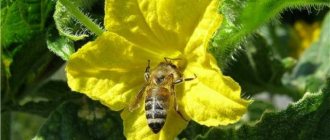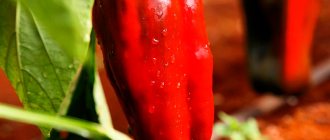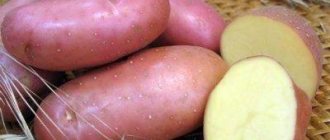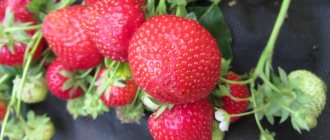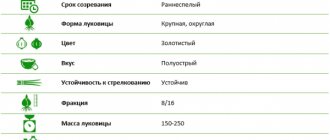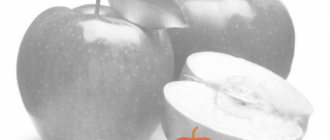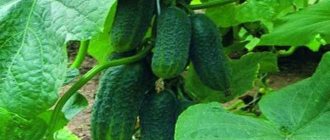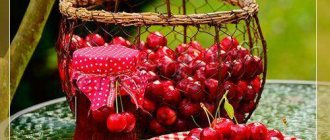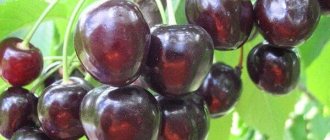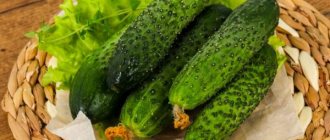Many farmers have already become familiar with the Temp F1 cucumber. The hybrid has been included in the State Register since 2006 and is intended for cultivation in 7 regions of the country (Central, Middle Volga, Northern, North Caucasian, Volga-Vyatka and Northwestern).
| Landing location | Ripening time | Mode of application | Fruit length | Group | Fruit smoothness | Pollination method |
| Universal | Early ripening (35-45 days) | Universal | Short (gherkins) - less than 10 cm | Hybrid | Highly lumpy | Parthenocarpic |
Bush care
When the sprouts begin to form into full-fledged bushes, it is important to ensure that the vines do not begin to creep along the ground.
In order to prevent the growth of stems, a trellis is installed. Today, there are many trellis models for both row and bush plantings
Gartering of vines must be done carefully, remembering that cucumber stems are very sensitive to wounds. Do not squeeze the plant too much, this can cause disruption of the circulation of juices in the stems and the plant will die.
During the period of intensive growth, it is important to pay special attention to loosening the soil and moistening the soil, bush, and leaves. It is important to remember that watering is carried out only with warm water preheated in the sun. If an irrigation system is installed in the garden that lifts liquid from the well, watering should be done immediately after the heat subsides, but it should be warm enough outside to warm up the already moist soil
If an irrigation system is installed in the garden that lifts liquid from the well, watering should be done immediately after the heat subsides, but it should be warm enough outside to warm up the already moist soil.
Description of the cucumber variety Temp
Now not a new variety of cucumbers, Temp F1 was added to the State Register of Breeding Achievements in 2006. This variety is zoned for seven regions of Russia: the Middle Volga and Volga-Vyatka, Northern and Northwestern, Central and Central Chernozem, as well as for the North Caucasus region.
Purpose of the Temp cucumber variety
Tempo is intended for cultivation in private plots. It is better to grow it in greenhouses, film or glass. As a parthenocarpic, Tempa F1 gives an excellent harvest when grown on balconies or on a windowsill at home. According to the State Register, the main condition for growing the variety is closed soil (labeled garden-garden or, in short, SZ).
The Temp cucumber belongs to the first generation hybrids, that is, the indicators obtained by crossing different varieties are superior to the parent ones, but are not transmitted. Therefore, Tempa seeds should not be collected, since they do not carry the hereditary characteristics of the variety.
Description of the cucumber bush Temp
The Temp cucumber is parnocarpic, meaning it can produce fruit without pollination. This is a big plus for greenhouse growing or growing in any other place that is not open to insects. The yield of the variety does not suffer at all from this.
The Temp variety bush is compact
The cucumber bush of the Temp variety is interminant, that is, it is unlimited in the growth of the central branch. At the end of the main lash there is no flower raceme, which can lead to its growth to a length of about two meters. The plant itself is weakly branched, with small, bright green leaves.
According to the type of cucumber flowering, the Temp variety is classified as female. This means that each of the three to five flowers in a node will turn into a fruit. There are no barren flowers on plants of the Temp variety.
Fruit ripening
The variety is an early one. You can harvest as early as 35–36 days after germination if you plan to collect pickles (cucumbers up to 5 centimeters in length). If you let the fruits grow to gherkins (7–9 centimeters), then their harvest will have to be postponed for a week. In the State Register, when describing the variety Temp F1, the average period of fruit ripening is stated - 43 days.
Description of the fruits of the Temp variety
Cucumbers on Temp F1 bushes grow together, reaching a marketable length of 8–10 centimeters. The plant can bear fruit until frost. With their cylindrical shape and dark green color, they attract the eye. Against a dark background, longitudinal stripes of a lighter green hue are clearly visible. The beautiful lumpy cucumber has a medium density, which it preserves in salads and preserved in jars. Each fruit is 70–80 grams of excellent taste.
Zelentsy Tempa everything is just right
Productivity of the Temp variety
The yield of the Temp F1 variety is quite high. On average, up to 15 kilograms of cucumbers can be harvested from one square meter. If the fruits are collected at the pickle stage, then the yield will be from 5 to 7 kilograms.
Variety Temp high-yielding
Tempa F1 fruits are intended for fresh consumption or canning. It is believed that cucumbers with black pubescence are better suited for pickles. But the fruits of the Temp F1 variety can be preserved well and are stored remarkably well.
Disease resistance of cucumbers
Temp F1 has proven itself as a variety resistant to many cucumber diseases. It is not susceptible to cladosporiosis and powdery mildew, and is tolerant to peronosporosis (downy mildew) and cucumber mosaic (BOM 1).
This is interesting: Puccini Cucumbers (video)
Description of fruits
The resulting ovary of Temp cucumbers takes the shape of a cylinder, has a short neck and medium-sized tubercles. The length of the fruit reaches 10 cm, and the weight is up to 80 g. The gherkin is up to 6 cm, weighing up to 50 g, and the pickle is up to 4 cm, weighing up to 20 g. It should be noted that ripe cucumbers are juicy, crispy, aromatic with a delicate crust. All fruits of the Temp-f1 variety grow to approximately the same size and look neat when placed in jars.
Eye diseases in rabbits: causes, symptoms, treatment with photos
Seedling
When is it better to plant seedlings? Temperature f 1 depends on how you plan to grow them: in a greenhouse or in open ground. For the first option, you need to attend to seedlings in early April
It is important to remember that, regardless of the variety, cucumbers do not tolerate transplantation well - too often such manipulations damage the root system of the plant. To avoid this, it is best to use “peat” pots.
You can transplant the sprouts directly into the greenhouse within twenty-five days.
In the case of open ground, everything is somewhat more complicated. You can plant sprouts in the garden when the weather is consistently warm. Most often this happens in early June. In this case, it is best to sow seedlings in early May.
Landing
Regardless of where Temp f 1 cucumbers will be planted - in the ground or in a greenhouse - there are several general, mandatory planting rules:
- You should not plant cucumbers in places where pumpkins or zucchini were grown last season.
- Planting more than 3-4 plants on an area of one square meter is fraught with the risk of cucumbers becoming infected with diseases or pests.
- The planting site should be well lit and located on the sunny side of the garden.
It is important to remember that, despite the fact that growing this variety in open ground is practiced by many gardeners, according to GOST Temp is greenhouse cucumbers
Video
You can learn about new agricultural breeding achievements in the field of hybrid cucumbers intended for cultivation in all regions of Russia from the following video:
For several years she worked as a television program editor with leading producers of ornamental plants in Ukraine. At the dacha, of all types of agricultural work, she prefers harvesting, but for this she is ready to regularly weed, pull, shed, water, tie, thin out, etc. I am convinced that the most delicious vegetables and fruits are those grown with your own hands!
Found a mistake? Select the text with the mouse and click:
Convenient Android applications have been developed to help gardeners and gardeners. First of all, these are sowing (lunar, flower, etc.) calendars, thematic magazines, and collections of useful tips. With their help, you can choose a day favorable for planting each type of plant, determine the timing of their ripening and harvest on time.
A new product from American developers is the Tertill robot, which weeds weeds in the garden. The device was invented under the leadership of John Downes (creator of the robot vacuum cleaner) and works autonomously in all weather conditions, moving over uneven surfaces on wheels. At the same time, it cuts off all plants below 3 cm with the built-in trimmer.
In Australia, scientists have begun experiments in cloning several varieties of grapes grown in cold regions. Climate warming, which is predicted for the next 50 years, will lead to their disappearance. Australian varieties have excellent characteristics for winemaking and are not susceptible to diseases common in Europe and America.
The homeland of pepper is America, but the main breeding work on developing sweet varieties was carried out, in particular, by Ferenc Horvath (Hungary) in the 20s. XX century in Europe, mainly in the Balkans. Pepper came to Russia from Bulgaria, which is why it received its usual name - “Bulgarian”.
Compost is rotted organic remains of various origins. How to do it? They put everything in a heap, hole or large box: kitchen scraps, tops of garden crops, weeds cut before flowering, thin twigs. All this is layered with phosphate rock, sometimes straw, earth or peat. (Some summer residents add special composting accelerators.) Cover with film. During the process of overheating, the pile is periodically turned or pierced to bring in fresh air. Typically, compost “ripens” for 2 years, but with modern additives it can be ready in one summer season.
Oklahoma farmer Carl Burns developed an unusual variety of multi-colored corn called Rainbow Corn. The grains on each cob are of different colors and shades: brown, pink, purple, blue, green, etc. This result was achieved through many years of selecting the most colored ordinary varieties and crossing them.
It is believed that some vegetables and fruits (cucumbers, stem celery, all varieties of cabbage, peppers, apples) have “negative calorie content,” that is, more calories are consumed during digestion than they contain. In fact, only 10-20% of the calories received from food are consumed in the digestive process.
You need to collect medicinal flowers and inflorescences at the very beginning of the flowering period, when the content of nutrients in them is highest. Flowers are supposed to be picked by hand, tearing off the rough stalks. Dry the collected flowers and herbs, scattered in a thin layer, in a cool room at natural temperature without access to direct sunlight.
From varietal tomatoes you can get “your own” seeds for sowing next year (if you really like the variety). But it is useless to do this with hybrids: you will get seeds, but they will carry the hereditary material not of the plant from which they were taken, but of its numerous “ancestors”.
Cucumbers are the most popular vegetable cultivated in open and closed ground. For gardeners and gardeners who prefer growing early parthenocorpic varieties in a greenhouse, advice on agricultural technology, a description of Temp cucumbers, reviews and photos of those who have already grown and received harvests from it will be useful. This variety has been on the market for more than ten years, and during this time it has acquired its fans, who have found a lot of advantages in it.
Advantages and disadvantages
Despite the fact that the culture has many advantages (from taste to high yield), there are also disadvantages. For example, Temp cucumber seeds are relatively expensive. Still, the result during the harvest season justifies its price. The plant begins to bear fruit early and brings a rich harvest, which can be used in many dishes.
Temp cucumber tolerates both 50-degree heat and cold with rain. If the summer is hot and dry, it requires increased watering. When planting crops, it is recommended to use the peat mulching method.
Before the flowering period begins, watering should be moderate. Water temperature is approximately +25°C. Fertilizing can be done with both minerals and organic fertilizers. It's good to alternate them with each other. Cow manure and bird droppings remain natural organic fertilizers. Fertilizing is carried out after watering, on moist soil.
The main guarantee of cucumber productivity is good soil, fertilized with minerals before planting.
During the growth of the plant, the soil must be constantly loosened and weeded, then the fruits will grow and develop faster. Some gardeners fertilize the soil immediately before planting seedlings in the ground.
I am glad that these cucumbers are one of the few types that have absolutely no bitterness. Even if the weather conditions were not the best.
Reviews from summer residents who have been growing Temp cucumbers for many years note the good resistance of the crop to temperature changes. Many reviews talk about the plant's resistance to disease and extraordinary productivity.
Cucumber is a unique vegetable that, without having any special taste, has won the recognition of housewives and gardeners, and the description of the Temp variety proves that it is its unique representative. Thanks to this hybrid, you can please your family with both a refreshing cucumber salad and delicious preserves.
Main characteristics of the variety
The hybrid cucumber variety Temp-f1 is classified as drought-resistant; the crop tends to survive high temperatures up to +50 °C. When adding seed, the temperature in the soil should not be lower than + 16 °C. In such conditions, cucumbers develop fully.
Productivity
The total yield per square meter varies between 11 - 15 kg. If the collection occurs at the stage of formation of pickles - up to 7 kg.
The yield of the Temp-f1 hybrid can be influenced by many different factors and nuances that are not taken into account:
- soil quality;
- landing site (shaded area, sunny side);
- climatic conditions;
- timely irrigation and fertilizing of cucumbers of the Temp-f1 variety;
- branching pattern;
- plant density;
- predecessor plants;
- frequency of harvesting.
Temp F1 cucumbers are an unpretentious variety, but this does not mean that they do not need care. The fact that they are resistant to diseases also does not exclude their occurrence. To avoid unpleasant phenomena, the beds should be fluffed after watering, fertilizers should be applied, and weeds should be controlled.
Resistance to pests and diseases
Typically, cucumbers are negatively affected by brown spot and powdery mildew, and the cucumber mosaic virus. Cucumber Temp f1 is resistant to common diseases, since drought, excessive watering, and rainy weather do not harm the variety.
Pros and cons of the variety
The cucumber variety Temp °f1 was bred for planting in greenhouse conditions. It deserves the attention of gardeners, as it has many advantages over other varieties:
- early ripening of cucumbers;
- attractive fruits and rich taste;
- disease resistance;
- self-pollinating;
- large harvests of cucumbers of the Temp-f1 variety;
- versatility;
- unpretentiousness.
Cucumber Temp-f1 does not require large areas for cultivation and does not lag behind in growth in constant shade.
The Temp-f1 variety has its disadvantages, which also affect the buyer’s choice. Hybrid cucumbers are not suitable for collecting seeds, and the price in stores for gardeners and gardeners is quite high.
Important! Many experienced summer residents claim that the high cost of seeding material for cucumbers of the Temp-f1 variety is offset by the absence of processing costs and large volumes of harvested crops.
Positive and negative qualities of a hybrid
The Temp cucumber, included in the State Register, was bred for film cultivation. The positive characteristics include the following:
- Very early ripening;
- Good disease resistance;
- High percentage of seed germination;
- High yield;
- No need for picking;
- Excellent transportability;
- Resistant to thickening and shade;
- Good appearance and taste;
- Drought resistance;
- Self-pollinating;
- The versatility of the fruit;
- Adaptation to soil conditions.
Speaking about the disadvantages, all consumers say that the most important of them is the very high cost. Other, less significant negative qualities were also noted:
- If the soil is highly acidic, the cucumber stops growing and withers;
- Sudden changes in temperature negatively affect the well-being of the plant;
- Under field conditions of growing vines, crops begin to quickly dry out, the foliage turns yellow, and the fruiting period is reduced;
- A long period of dehydration leads to crushing of the fruit.
The consumer is very attracted by the lack of bitterness in the product, even when cultivated on difficult soils. Another important advantage is parthenocarpicity, which allows you to keep cucumber bushes on balconies and loggias.
This is interesting: Loofah - how to grow and care for a vine
Advantages and disadvantages
Temp cucumber is very popular for good reasons. The main ones:
- the variety has a bouquet type of ovaries;
- very early ripening;
- small fruits look very presentable and have an amazing taste;
- good immunity to cucumber diseases;
- Bees are not needed for pollination;
- excellent yield indicators;
- The variety tolerates shade and drought remarkably well.
Important! Temp cucumbers have only one drawback - high cost!
The weight of one fruit is 70-80 grams
Advantages of a hybrid:
- high productivity;
- ability to adapt to almost any growing conditions;
- resistance to many cucumber diseases;
- almost one hundred percent germination of seed;
- heat resistance;
- self-pollinating;
- ability to bear fruit in the shade;
- resistance to thickening of plantings.
Gardeners love the hybrid for its lack of bitterness in the fruits and its ability to develop in difficult conditions. Parthenocarpic pollination allows you to grow Temp F1 on balconies and loggias of apartments.
Despite its advantages, culture has disadvantages:
- reacts poorly to highly acidic soils;
- does not tolerate sudden temperature changes;
- lack of moisture makes the fruits small;
- the seeds are relatively expensive - about 100 rubles. per package (10 seeds).
The cucumber hybrid "Temp-f1" is included in the State Register, is intended for cultivation under film covers and has the following positive characteristics:
- early ripening;
- decent appearance and taste of fruits;
- high resistance to VOM and low level of damage to other diseases;
- self-pollinating;
- high productivity;
- universal use of fruits;
- unpretentiousness;
- shade tolerance, resistance to dense plantings.
The advantages of the Temp (F1) variety include:
- Excellent productivity;
- High taste qualities of greens;
- Early maturation;
- Commercial value of fruits;
- Resistance to high temperatures;
- Self-pollinating;
- Universal use of greens;
The disadvantage of the hybrid is the high cost of planting material.
- Low maintenance;
- Shade tolerance;
- Resistance to thickened plantings.;
- Strong immunity to most diseases.
Description of the variety
Recommended for cultivation in seven regions of Russia, including Northern, Northwestern, and Middle Volga. It is considered one of the best hybrids of domestic selection among gherkin-type cucumbers, and is one of the leaders in the group of canned varieties of the crop.
Characteristics of cucumber Temp F1
Bushes of indeterminate type, with small lateral shoots, open. There are few leaves, the branching is weak. The foliage color is bright green, the plates are slightly wrinkled.
The F1 rate produces bunched ovaries, the type of flowering is female. There are three to five ovary nodes; according to the type of weaving, it belongs to cucumbers with limited branching. This greatly simplifies the care of the crop, so the gherkin cucumber is recommended for planting by beginning gardeners.
On a note!
By providing the plants in the greenhouse with maximum illumination, the bunchiness of the cucumber increases. The largest number of ovaries is formed in the upper tier of the bush.
The hybrid form is early; the timing of harvest depends on the stage at which the greens are harvested. Pickles - cucumbers 3-5 cm, ripen already 36-38 days after the appearance of full shoots. Harvesting the first batch of gherkins (up to 7 cm) is possible on days 40-44.
The cucumbers are short, do not exceed 9 cm in length, and have a regular oval shape. All fruits are smooth, with dense but thin skin, tuberculate. The spines are white and small. The color is dark green, with whitish stripes. On average, the weight of greens does not exceed 90-100 grams. Oval green greens with stripes of color, medium density.
The pulp is juicy, dense, crispy. There are no voids inside, like seeds. The taste is pleasant, “cucumber”, without bitterness. The absence of bitterness is a genetic characteristic, therefore, even if the harvest of Tempa greens is delayed, the fruits do not become bitter, do not turn yellow, and do not overgrow.
The main purpose of the hybrid is preservation, salting, and preparation of all kinds of marinades. Gardeners note the excellent taste of salted, pickled, canned pickles and gherkins, the complete preservation of the shape of the fruit, and the presence of a “crunch.” Zelentsy are suitable for transportation and have good shelf life.
You may be interested in:
Advantages and disadvantages of a hybrid
The cucumber from Semko Junior is popular; the seeds of the hybrid are constantly asked for in specialized stores.
Advantages of the variety:
- early harvest dates;
- good taste;
- thanks to limited branching, plant care is greatly simplified;
- high yield rates (up to 10 kg of pickles are harvested from 1 sq. meter, 18-20 kg of gherkins - in closed ground);
- complex resistance to diseases (cladosporiosis, powdery mildew);
- quick adaptation to various weather anomalies and stress.
The hybrid tolerates temporary cold snaps well, is drought-resistant, and does not shed flowers and ovaries during prolonged cloudy weather. Additional “advantages” include a simplified scheme for plant formation, a bouquet type of ovary formation, the possibility of planting in shelters and in open ground (in the south).
Flaws:
- the need to purchase seeds annually, since seed material for planting is not collected from first-generation hybrids;
- high cost of seeds;
- demands on nutrition if you plan to receive greens in bunches.
Regarding the high cost, many summer residents note that the costs are fully recouped when the harvest ripens. Tempo F1 lives up to its name; it bears fruit abundantly and for a long time.
This is interesting: Cucumber Monisia F1 - description, advantages and disadvantages, real reviews
Plant resistance to diseases
Tempo F1 is highly resistant to pests and diseases. Breeders protected it from:
- powdery mildew;
- peronosporosis;
- cladosporiosis;
- mosaic disease.
Fungal diseases often appear as a white coating on bushes and leaf blades. The reasons for the formation are improper watering and temperature changes. Fungicides and copper sulfate are used for treatment. All infected parts of the plant should be immediately pulled out and destroyed.
Olive spot (cladosporiosis) is a fungal disease. It parasitizes plants as a result of temperature fluctuations. Brown spots cover the leaves and lashes, gradually drying out. The growth of cucumbers stops. Use a fungicide as a preventative measure.
The hybrid origin of the variety means that it is vulnerable to disease, so prevention is necessary. Premature administration of the necessary medications will help prevent the occurrence of unwanted diseases. The main pests for cucumbers are:
- bedbugs;
- aphid;
- slugs
Matsoni - what is it? Benefits and harms, what to eat with and recipe
The leaves curl when the cucumber bug appears. For treatment, use an infusion of tobacco or chamomile. Spray the lower parts of cucumber bushes with it twice in one month.
Aphids interfere with the green mass, creating a good environment for bacteria to multiply. The leaf blades wrinkle. For prevention, weeds must be removed. Red pepper works well in the fight against aphids.
Description of cucumbers
The hybrid is intended for cultivation in protected ground. The culture is distinguished by bunch fruiting, the lateral shoots are poorly developed. The leaves are heart-shaped with 5 lobes, the stem has the appearance of a creeping whip, ending with tendrils with which the plant clings to the support.
The fruits are elongated, cylindrical, covered with lumpy green skin with white spines and light longitudinal stripes. On one node, 3–5 vegetables are formed, weighing from 50 to 80 g, 3–9 cm long. It blooms with single yellow inflorescences of medium size.
Distinctive features
Tempo differs from other cultures:
- seed germination rate of 95–99%;
- parthenocarpic fertilization (does not require pollination);
- lack of bitterness in fruits;
- the ability to grow at home;
- innate immunity to cultural diseases.
Composition and properties
The calorie content of the fruit is 13 kcal. 100 g of product contains:
- 0.8 g proteins;
- 2.4 g carbohydrates;
- 0.1 g fat.
Cucumbers not only have a refreshing taste, but also a rich chemical composition. These include:
- alimentary fiber;
- organic acids;
- provitamin A;
- biotin;
- B vitamins (thiamine, choline, folate, pyridoxine, riboflavin, pantothenic acid);
- ascorbic acid;
- alpha tocopherol;
- phylloquinone (vitamin K);
- vitamin PP;
- niacin;
- macroelements (sulfur, potassium, chlorine, calcium, phosphorus, magnesium, silicon, sodium);
- trace elements (aluminum, zinc, boron, iodine, iron, fluorine, chromium, manganese, selenium).
The fruits of the crop have beneficial properties:
- replenish the lack of fluid in the body;
- relieve heartburn;
- remove waste, toxins, heavy metal salts and excess water;
- improve digestion;
- prevent the formation of adipose tissue;
- reduce cholesterol levels;
- normalize blood pressure;
- treat sore gums;
- improve the condition of hair and nails;
- relieve pain from gout, arthritis;
- improve joint condition;
- relieve hangovers, remove harmful substances formed when drinking alcoholic beverages;
- reduce the concentration of uric acid;
- regulate kidney function.
Characteristics
The table below shows the main characteristics of the hybrid:
| Bushes |
|
| Ripening time | From germination to the formation of pickles, 37-38 days pass, gherkins - 42-44 days. |
| Fruit | Pickles are 3–5 cm in length, gherkins are 7–9 cm. Weight is 50–80 g, diameter is 2–4 cm. |
| Taste and purpose | Pulp:
Cucumbers are consumed fresh, pickled, salted, and preserved for the winter. |
| Productivity | At the pickle stage - 9-10 kg/m2. If you wait for the fruits to fully ripen, then up to 25 kg of crop can be harvested from 1 m2. |
| Pollination type | Parthenocarpic |
| Disease resistance | Congenital, high |
Taste qualities of cucumbers
The fruits of the Temp variety have pronounced tubercles on the surface, their shape is normal, cylindrical. The diameter at the gherkin stage reaches 4 cm. The average weight of the fruit is about 70 g; cucumbers weighing from 35 g are suitable for harvesting.
Temp cucumbers are slightly pubescent and have white spines. The fruit pulp is dense, with a strong aroma and a sweetish taste without bitterness. When bitten, the fruit crunches; there are no voids in the middle. Fruiting continues until frost. If cucumbers are not picked in time, they do not outgrow.
Collected at the pickle or gherkin stage, the fruits are suitable for consumption fresh or canned. In salads they are combined with onions, tomatoes, peppers, and used as a side dish for meat dishes. Fresh vegetables are most beneficial. Preserving the summer harvest, Temp cucumbers are used in pickles, canned salads, and preparations for pickles.
Features of agricultural technology
Cucumber Temp has excellent resistance to cladosporiosis, powdery mildew, downy mildew, and viral mosaic
Infection is not excluded, but it is important to take preventive measures in a timely manner to avoid serious consequences. If a lesion is detected on a bush, it is disposed of, and the remaining bushes are carefully treated with specialized preparations.
The last ten days of May are chosen for planting cucumbers. You need to deepen the seeds in the soil a couple of centimeters. The distance between the beds should be at least 50 cm, and as soon as the seedlings appear, thinning is done. The end result should be 3 cucumbers per 1 m².
The bed should consist of fertile soil, and then sprinkle it with 15 cm of soil. It is advisable to plant the crop in the place where the following previously grew:
- potato;
- tomatoes;
- legumes
- You cannot plant Temp where a pumpkin previously grew.
The vegetable will grow well only in light and thoroughly fertilized soil. Exactly how the beds will be distributed is not particularly important, since they can be transverse or longitudinal. It is necessary to water the plants in a timely manner.
Why do cucumber ovaries dry out in a greenhouse and how to deal with it? Many summer residents have more than once encountered a situation where, for no particular reason, cucumber ovaries change color and fall off...
Sowing is carried out when the temperature is stably maintained at +16+18C. During sowing, the seeds need to be mulched with a 2-3 cm layer of peat. In addition, you need:
- cover the bed with film until the first shoots appear;
- in the middle zone, place seed material in greenhouse conditions;
- grow the product in seedlings, which is important for cold regions;
- water with settled water, the temperature of which is maintained up to +20+25C;
- harden plants before planting in beds;
- maintain the air temperature in the greenhouse not lower than +22 during the day and not lower than +16 at night;
- apply fertilizer at the root using urea, superphosphate, sulfate and potassium chloride.
Note! When thinning, choose bushes with thick stems, short spaces between nodes and a rich green color.
Caring for cucumbers is to:
- protect sprouts from frost;
- carry out timely hilling;
- irrigate the bushes;
- feed them with the necessary microelements.
The best varieties of cucumbers for open ground for the Moscow region Cucumbers are one of the most popular crops grown in the regions of the Moscow region. However, to get...
To prevent contact with low temperatures, it is worth using arcs and covering material. If the soil is not covered with mulch, then the top crust should be constantly loosened. Flush the soil after each rain. Experienced gardeners prefer drip moisture.
It is especially important to form bushes in a timely manner. If cultivation is carried out using a trellis, then the lower leaves will not rot, they will be able to receive enough light and, accordingly, the harvest can be much richer and tastier.
In addition, the trellis technique helps to avoid powdery mildew.
The hybrid begins to bear fruit very early and the fruiting period lasts quite a long time
It is important to harvest vegetables in a timely manner when their length reaches about 4-5 cm, which will help increase productivity. Proper care following the recommendations will allow you to get a tasty harvest from June until the end of September
Note! The variety is used for large-scale cultivation for subsequent sale, since cucumbers tolerate transportation well, do not spoil for a long time and do not lose their taste.
Features of growing cucumber Temp F1
Recommended for planting in greenhouses (film, polycarbonate), since in closed ground conditions with adequate nutrition it fully displays its potential. In areas of risky farming, growing in greenhouses speeds up the time for obtaining early gherkin products.
Growing seedlings
Due to the climate in most regions of the Russian Federation, cucumbers are grown through seedlings. Sowing dates are calculated based on the climate and weather of the area, as well as the future planting site (in shelters or on open-air ridges).
Approximate landing times:
- in the middle zone - in April (for planting in greenhouses in May), in early May - for planting on ridges;
- in the south - immediately by seeds in April-May in open ground;
- in Siberia and the Urals - at the end of April for planting in greenhouses, at the beginning of May - for planting on ridges.
For planting, use plastic cups, peat tablets, and pots. The crop does not tolerate transplants well and does not take root well due to damage to the root system. Therefore, the best option is to plant seedlings directly in pots (peat), or by transferring them from plastic containers.
Agro hybrids are sold with pre-treatment of seeds, so no soaking or disinfection procedures are required. Sow immediately in the soil mixture, and when seedlings appear, place them in a bright place.
The temperature when growing seedlings is approximately +20ºC…+23ºC. Irrigation is regular, without waterlogging or drying out the soil. Usually, cucumber seedlings do not need additional feeding, since the seeds are sown in fertile soil mixture. But if necessary, use ready-made compositions for seedlings - Agricola, Kemira Lux. Cucumbers are planted in a permanent place as soon as the soil warms up (+14ºC…+15ºC). For each square meter, 3-4 Temp F1 cucumber bushes are planted.
You may be interested in:
Choosing cucumbers for a polycarbonate greenhouse If you plan to grow cucumbers in a greenhouse, then you should correctly select the most suitable varieties for this.... Read more...
Agricultural technology of culture
When growing, the traditional scheme is used:
- watering;
- weeding;
- loosening;
- application of fertilizers.
For bunch hybrids, the formation of a bush is mandatory, but since this cucumber has limited branching, care is simple.
Cucumbers love moisture, but waterlogging of the soil and high air humidity harm the crop, as conditions are created for the occurrence of various fungal infections. Before flowering, the watering rate is 1-1.5 liters per plant; from the moment of flowering and the beginning of fruiting, the rate is increased to 4-5 liters.
For greenhouse cucumbers, it is recommended to organize drip irrigation systems; in their absence, water into the furrows and rows, so as not to expose the plant roots to water.
Good results are obtained by mulching the rows with chopped straw, hay, sawdust, and peat. Water in the morning or late afternoon, avoiding moisture getting on the leaves, ovaries and fruits of cucumbers.
Parthenocarpic bunch cucumbers require regular feeding. Cucumbers love organic matter, so in the initial period of cultivation they are fed with diluted mullein and poultry droppings. From the second half of the growing season, phosphorus and potassium (potassium monophosphate, superphosphate, wood ash) predominate in fertilizing. This helps to improve the taste of the fruit, increase the formation of ovaries, and the resistance of the crop to adverse weather conditions. A good folk remedy for cucumbers is a yeast solution (applied once a season with the obligatory addition of ash), green herbal infusions.
Gardeners also use chelated fertilizers, which contain macro- and micronutrients beneficial to the crop. Such compositions not only provide additional nutrition, but also protect cucumbers from infections.
Hybrid Temp F1 is a cucumber with limited branching. The lateral branches form shortened internodes. Basic techniques for forming a bush:
- blinding of ovaries and flowers in the lower part of the central shoot (up to 4 nodes);
- pinching lashes up to 50-60 cm in height along the stem (leave a leaf and 1 ovary);
- pinching shoots from half a meter to 1.5 meters (leaving 2 leaves and two ovaries).
When the central stem reaches the trellis, it is thrown over a rope or wire and fixed. After about 10-20 cm, the stem is pinched, allowing the growth of side shoots.
Flaws
And the disadvantages that characterize the Temp f1 cucumber include:
- reaction to highly acidic soil;
- sensitivity to sudden changes in temperature;
- if the soil is insufficiently moistened, the fruits may become smaller;
- in open ground and in field conditions, drying out of vines and yellowing of leaves is observed.
The main feature that attracts the attention of gardeners in choosing this particular type of cucumber is the lack of bitterness, even if the bush grows in difficult soil conditions. In addition, the parthenocarpic type of pollination of this hybrid allows it to be grown even on a balcony or in closed boxes
Optimal growing conditions
Despite the fact that cucumber is a light-loving plant that grows poorly in shade, the Temp variety can easily tolerate light shade without losing productivity. But this feature should not be abused, since a long absence of sun leads to weakening of the plant, its aging and loss of resistance to disease.
Its optimal temperature for development is 22 - 26 o C. The growth of cucumber variety Temp slows down if it drops below 14 o C. When it drops to 12 o C or less, the roots lose their ability to take moisture from the soil. Negative temperatures lead to complete death of plants. Ventilation of greenhouses should be carried out gradually, as the air warms up to comfortable conditions.
Seedling method
Cucumber seedlings are grown in order to obtain the first harvest a couple of weeks earlier than when sowing seed directly into the ground. Hybrid cucumbers "Temp-f1" are grown in seedlings most often in the central and northern regions of Russia.
It is advisable to grow cucumber seedlings in special boxes for one month, and then transplant the plants into greenhouses or open ground. Cucumber seedlings are very difficult to tolerate picking, and in addition, they need to comply with the following growing rules:
- You need to water the seedlings with warm, heated to 20-25°C, settled water;
- the temperature during the day should be maintained at 18-22°C, and at night reduced to 18°C;
- double feeding should be done with a solution of urea, potassium chloride or sulfate and superphosphate;
- a week before planting, the seedlings are hardened at a temperature of 12-13°C.
Good cucumber seedlings should have a thick stem, short internodes and a dark green color.
Criteria for selecting quality seeds
You need to choose seeds for planting based on several important points. New varieties and hybrids are created taking into account many factors; each type of vegetable has a list of advantages and inevitable disadvantages. Summer residents should consider the following properties when choosing:
- if you want to prepare seed material yourself in the future, choose a variety, not a hybrid;
- fruiting time - in order to eat cucumbers all season, you need to take into account how long the vegetable will bear fruit;
- resistance against diseases - hybrids in this regard show better properties than varieties;
- method of pollination and place of cultivation - if there is a lack of bees in the area and cultivation under film or in a greenhouse, you need to take self-pollinating species;
- genetically inherent lack of bitterness;
- verified seed manufacturer, certificates, specialized store.
"Temp F1": biological description, history
The hybrid was the result of breeding work by Semko-Junior LLC. The employees set their goal to develop a hardy cucumber that can easily withstand adverse weather conditions. In 2006 it was achieved. At the same time, “Temp” was included in the State Register of Breeding Achievements of the Russian Federation. The hybrid is approved for cultivation in the Northern, Northwestern, Central, Volga-Vyatka, Central Black Sea region, North Caucasus, Middle Volga regions. In an official document, it is recommended for cultivation under film cover in personal plots, however, it also demonstrates good productivity in open ground.
Bushes
Plants are indeterminate with weak branching. The shoots are covered with medium-sized leaves, colored intensely green. The edges are wavy. There are 3 pieces in the leaf axils. Inflorescences of a predominantly female type are formed, which do not require pollination by bees. The hybrid is parthenocarpic. The ovary is formed even in rainy spring-summer conditions.
Fruit
Over time, an ovary appears in place of the flowers. The type of formation is fascicle. In each sinus, 3-5 cylindrical greens are noted. Fruits are shortened. Maximum length – 10 cm. Weight – 70-80 g. The pulp is of medium density with a strong aroma, which is felt when broken even at the pickle stage, covered with a thin peel. The latter shows evenly distributed lighter stripes and tuberculation. The omission is white.
Productivity
The description of the hybrid notes its high yield. Moreover, no loss in quantity is observed even with shading or thickening.
Collecting pickles up to 7 cm in size produces a result of about 7 kg per 1 m², and when collecting larger fruits, within 10 cm, the weight of the harvest can increase to 7 kg per bush. This is equivalent to up to 15 kg per 1 m².
Characteristics and description of the Shosha variety with photos
seeds of the hybrid "Shosha f1" from
When testing the practicality and conditions for growing cucumber, examining its yield indicators, the plant was cultivated in open ground, in greenhouses, and in a barrel. Everywhere the hybrid distinguished itself with an excellent harvest. Shosha is declared as an early ripening crop.
The crop is approved for cultivation in any region of the country. Persistent and unpretentious cucumbers can be grown:
- In greenhouses and greenhouses;
- In open areas;
- On the windowsills of residential premises.
Since Shosha is a hybrid, its planting material is always labeled F1. Packaged material or loose seeds without such markings are unacceptable and may be considered counterfeit.
The cucumber bush belongs to the indeterminate type, medium branched, well leafy. The main stem often exceeds 2 meters in height and often approaches the 2.5 m mark. In addition to the angular, heart-shaped foliage of medium size, the shrub contains quite large specimens measuring 38x30 cm. The leaves are moderately wrinkled and have a rough surface, holding onto the stems with long petioles .
The plant is fed by a powerful root system. The parthenocarpic hybrid has a female type of flowering. The bouquet type of fruiting involves the formation of 3-4 ovaries in each node.
Zelentsy Shosha are distinguished by high commercial quality: strong, elastic, having a beautiful elongated cylindrical shape. The average parameters of the fruit are as follows:
- Diameter – 3cm;
- Length – 9-12 cm;
- Weight – 55-65 g.
The medium-tubercular surface of the cucumber has a white edge. The pulp itself is tender, light green, crispy and aromatic. No voids are formed in the fruits. Moderately sweet taste has no bitterness. The filled seed chambers contain milky ripe seeds.
Shosha has a very long growing season, and in greenhouse conditions it continues to bear fruit when other cucumbers have already finished their growing season. The high immunity of cucumber makes it resistant to mosaic, powdery mildew, and target spot.
The hybrid is very resistant to weather changes and unfavorable climate conditions.
The parthenocarpic properties of Shoshi make it possible to set fruit indoors even in winter.
Fruits that have reached 10-11 cm are harvested but remain unnoticed; the cucumbers will not outgrow the parameters specified in the characteristics and will not lose their juiciness and delicate taste. The use of greens is universal, but they are most delicious when lightly salted.
Cucumber abundance or the most productive varieties of cucumbers
Some gardeners do not grow potatoes, others do not grow carrots and onions, and others do not grow cabbage. But it’s almost impossible to find a garden where cucumbers don’t grow! This healthy vegetable has firmly taken its place as the leader in summer cottages.
Secrets of a rich harvest
To successfully grow cucumbers, you should know the main agronomic requirements:
Don't forget to follow the requirements for growing cucumbers
Warm. Cold weather is very destructive, especially for young shoots. At temperatures below 15 degrees, cucumbers will stop growing and may die completely. Therefore, there is no need to rush with sowing. The best time is mid-May - early June, and for greenhouses and greenhouses - early May.
Good lighting. A sunny place is the best choice for a cucumber bed. Maximum – slight partial shade. Otherwise, the side shoots will slow down in growth and fruiting will be delayed. For the same reason, it is not recommended to thicken crops. The optimal distance between specimens is at least twenty centimeters.
Moisture. Cucumbers should “drink” a lot, especially during the period of growth and active development of the fruit. Lack of water leads to a deterioration in the taste properties of greens, for example, to bitterness. It is advisable to use warm, settled water for irrigation.
Applying fertilizers before planting. It has long been noted that the most generous harvest is obtained where organic matter has previously been added - humus, manure, mullein. In such beds there is no need for further fertilizing.
In addition to the above requirements, a significant factor is the correctly selected variety of cucumbers.
Nuances of the right choice
Before purchasing seeds, you need to pay attention to the following subtleties:
The purpose of greens. To eat fruits fresh, you should choose salad varieties with a more pronounced smell and taste. Such cucumbers are not suitable for preparations. When cooked and exposed to acids (acetic, citric), they become soft and tasteless. Are you planning to marinate and process vegetables for the winter? Then you need to take varieties suitable for canning and pickling.
These cucumbers remain firm, crispy and do not fall apart when exposed to high temperatures.
Climatic features. The higher the region is located on the map of the Russian Federation, the more attention should be paid to varietal characteristics.
Southern cucumbers simply will not have time to grow during the short northern summer, and cold-resistant specimens will not withstand the scorching rays of hot areas.
Of course, there are types of cucumbers that can adapt to climatic conditions, but there are very few such varieties.
Observe the climatic characteristics of certain varieties
The same condition applies to samples of foreign selection. It is worth setting aside a place for them in a greenhouse. It will be a great pity for the wasted time and considerable financial expenses if the “foreigners” die.
Place of cultivation. There are two options: greenhouse or open ground. Almost any variety of greens is suitable for growing without shelter, but it will be more comfortable to plant self-pollinating or parthenocarpic species in a greenhouse.
Cucumbers are also divided into varietal and hybrid. There is a version that hybrids give greater yield. But it will not be possible to prepare seeds from such plants, since the maternal properties of the hybrids are not preserved.
The best cucumber varieties for yield
The assortment of seeds expands every year; both new products and already tested, but no less in demand, varieties are displayed on the shelves. Which ones are rightfully called champions?
Zozulya F1. An early representative of the family, long and deservedly loved by vegetable growers. The fruits are elongated, with white spines. It has partial parthenocarpy, therefore suitable for both open ground and greenhouses. The purpose is universal. Resistant to many diseases.
Masha F1. Early ripening parthenocarpic hybrid. Gherkins are up to 11 centimeters long, very pimpled, without bitterness. Used in prepared or fresh form. Immune to viral mosaic, powdery mildew and similar diseases.
Fontana F1. The variety is bee-pollinated, mid-early, pickling. Very productive. The fruits are black-thorned, weighing about 100 grams, and are not bitter. Color – light green, with clear stripes.
Courage F1. The plant is self-pollinating. Fruiting occurs after 50 days. Excellent taste characteristics of greens, combined purpose. The color of cucumbers is dark green with white spines.
There are a huge variety of hybrids
Herman F1. We are respected by summer residents for their endurance: an excellent harvest even in the cold summer! Refers to early hybrids of the parthenocarpic type. The fruits are of universal use.
Bush. The name speaks for itself: the plant, increasing in size, takes on the shape of a bush. It is used for planting in open ground, as pollinating insects are needed. The taste of cucumbers is sweetish. The fruits are large-tubercular, ripen quickly and do not turn yellow for a long time. Disease resistance.
Competitor. Time-tested, pickling, high-yielding variety. Cucumbers weighing up to 150 grams, green, striped, with black spines. Bee-pollinated species.
It should be remembered that smooth greens with almost no thorns or with a slight fluff are most often salad varieties.
The fruits are very pimply and dark-spiked, most likely universal in use and suitable for both pickling and preparing fresh vegetable side dishes.
For self-pollinating species, it is advisable to plant a pollinator plant, otherwise the cucumber will not be able to display its genetically inherent characteristics.
Home garden
In recent years, “balcony” growing of vegetables has become increasingly popular. Having your own harvest on the windowsill is no longer a dream, but a feasible reality. Cucumbers also take pride of place here. Among them, the following stand out:
City cucumber F1. The undisputed leader of this group. Ultra early variety. The fruits are small striped gherkins that grow in bunches. Delicious in any form. Shade-tolerant and disease-resistant.
Balcony F1. Another worthy representative of home vegetable growing. Quite a compact hybrid, branching is average. The cucumbers are approximately 8-10 cm in size and grow several in a bunch. The purpose is universal.
Swallowtail F1. The plant is parthenocarpic, the fruits are quite large - about 110 grams. With the necessary care, it forms many ovaries at the same time. Zelentsy can be used in canning, or you can crunch the freshly harvested harvest.
Many varieties of cucumbers are great for canning.
Blizzard F1. Ultra-early and one of the fastest growing window hybrids. It practically does not form side shoots, it grows mainly in one stem, which is very convenient. Small fruits ripen at the same time.
F1 calendar. Bunched balcony parthenocarp. The leaves are small, forming up to six ovaries per node. Gherkins are striped green, shiny, weighing no more than 90 grams.
Showcase F1. Very tasty large lumpy, crispy gherkins. The side shoots of the plant are short. The variety is resistant to mosaic virus, olive spot, and powdery mildew.
When growing cucumbers at home, you need to choose only self-pollinating species and it is better if they are hybrid varieties adapted for the balcony. Although some city residents successfully grow Libelle and Zozulya.
The best varieties for the greenhouse
The most important criteria that you need to focus on when selecting cucumbers for a greenhouse are self-pollination and plant size. The presence of insects cannot be guaranteed. Manual pollination is a rather labor-intensive and time-consuming procedure.
Table: description of cucumber varieties suitable for cultivation in greenhouses
| Variety name | Most suitable region for cultivation | Ripening time | Self-pollinating | Appearance of the bush | Type of ovary | Presence of immunity | Dangerous diseases | Appearance and taste of fruits | Productivity, fruiting | Other characteristic features |
| Son-in-law | Central | Early (42 days) | Yes | The bush is indeterminate, the branching intensity is average | Bundle, 3 or more fruits | Powdery mildew | Downy mildew | Zelentsy weigh about 90 g, grow to 8–10 cm. The skin is streaked with vague pale green stripes. The tubercles are numerous, medium-sized, the edges are densely whitish, the spines are soft. Cucumber, in principle, without the slightest bitterness | Up to 13.2 kg/m² | Easy to care for. Does not pay attention to hot weather and high humidity. When outgrown, the pulp and skin retain their color and density, but the shape of the fruit changes from elliptical to barrel-shaped |
| Mother-in-law | Central, Northwestern. But the experience of gardeners shows that this cucumber can withstand more severe climatic conditions. | Early (44 days) | Yes | Indeterminate bush, medium branched | Bundle, 3 or more fruits | Powdery mildew | Downy mildew | Zelentsy grow up to 10–12 cm and gain a weight of 102 g. The entire skin is covered with fuzzy pale green streaks. The cucumber is finely tuberculate, the edges are whitish, and not particularly dense. Pulp without voids. | 12.2 kg/m² | The flowers are mostly female |
| Tempo F1 | Recognized as most suitable for cultivation west of the Urals, but successfully takes root and bears fruit in a sharply continental climate | Early (43 days) | Yes | The plant is indeterminate, with few lateral branches formed. | Bundle, more than 3 fruits | Cladosporiosis, powdery mildew | Downy mildew, mosaic virus | Zelenets reaches a length of 6–8 cm and gains a mass of 70–80 g, and is noticeably tuberous. The lower half is streaked with narrow white strokes. The edge is whitish, sparse. The pulp is completely free of bitterness and voids | More than 14 kg/m² | Flowers are only female. The variety survives drought very well |
| red mullet | It shows itself best in the European part of Russia, but also in the Urals and beyond it produces good harvests | Early (43 days) | Yes | Indeterminate bush, actively branching | Bundle, more than 3 fruits | Powdery mildew | Downy mildew | Zelentsy grow up to 8–9 cm and gain a mass of 95 g. The tubercles are not particularly noticeable, but numerous. The edge is not too thick, white. About a third of the vegetable below is covered with vague pale streaks. The pulp is devoid of bitterness | 14.8 kg/m². Fruiting lasts about two months | The flowers are exclusively female. Overripe fruits do not turn yellow or overgrow. |
Description
This hybrid belongs to the group of parthenocarpic plants that do not require pollination by insects. The ovaries develop without fertilization, so the seeds do not ripen in the fruits.
Like most parthenocarpics, the “Temp F1” cucumber has a female flowering type, that is, each flower requires the presence of an ovary
The plant is indeterminate (without natural restrictions in growth), but quite open, with small leaves and weak branching - it produces a limited number of lateral shoots. There are no particular difficulties in care associated with the formation of the bush. Weak branching promotes fruiting activity on the central stem and early ripening. The first harvest is formed by the 37-38th (pickles) or 42-44th (gherkins) days after germination. In the variety with the female type of flowering, the ovaries are laid in bunches of 3 or more at the nodes. In good light conditions, the tendency to bunch fruiting increases, the number of ovaries in bunches increases (especially in the upper part of the bush).
Weak branching allows these cucumbers to be planted denser than others: the recommended planting density is 3.5-4 plants per 1 m2
Cucumber "Temp F1" is intended for collecting pickles (3-5 cm) and gherkins (7-9 cm). The average weight of the fruit at the stage of technical maturity is 70-80 g. Zelentsy have a cylindrical shape with a short neck and a dark green color with longitudinal light stripes of medium length. The surface is covered with tubercles and loose white pubescence. The pulp is strong (without voids) and crispy, the taste of fresh and canned greens is excellent (without bitterness). Even fruits that are not picked on time do not outgrow or turn yellow, they have a uniform appearance and good shelf life, which allows you to transport and store the harvest without loss of quality. The marketable yield in greenhouses is 9-10 kg/m2 of pickles and more than 20 kg/m2 of gherkins.
Pickles and gherkins of this hybrid are universal in purpose, highly valued for their excellent taste in all forms: fresh, salted and pickled.
The listed characteristics explain the popularity of cucumbers of this variety not only among amateur gardeners, but also in many farms and greenhouses where they are grown for commercial production. It remains to add that this hybrid is well adapted to weather stress (temperature changes, heat up to +50 ℃), does not reduce the rate of fruiting during cloudy and rainy periods, and has complex resistance to diseases:
- high - to olive spot (cladosporiosis) and powdery mildew;
- medium - to the common cucumber mosaic virus (VOM 1) and downy mildew (peronospora).
In the photo - packages with seeds of the hybrid variety of cucumbers "Temp F1" from various manufacturers
The main disadvantage of Temp F1 cucumbers, according to many gardeners, is the high cost of seed material. But with regard to parthenocarpic hybrids, it is better not to skimp on the quality of seeds. Conscientious producers, such as agro, carefully select and pre-treat the seeds of their cucumbers (“Temp F1”, “Paratunka F1”, etc.), which ensures germination at 99% and full compliance with the declared varietal characteristics.
